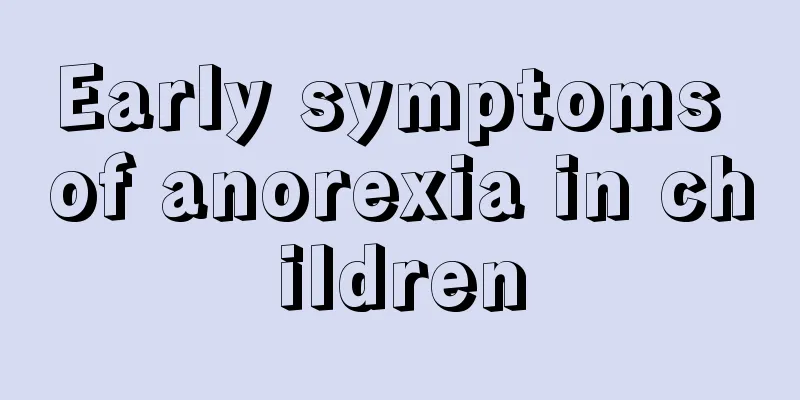Early symptoms of anorexia in children

|
For parents, feeding children is a difficult problem. Because many children are very picky eaters, and nowadays there are all kinds of snacks available. Children will eat snacks such as potato chips and jelly before having a regular meal, and then start to refuse to eat once it is time to eat. In more serious cases, children may suffer from anorexia and lose interest in eating at all. What are the early symptoms of anorexia in children? Anorexia in children refers to the symptoms of long-term loss of appetite or lack of appetite in children (mainly 3 to 6 years old). It is a symptom, not a separate disease. Anorexia in children, also known as digestive dysfunction, is very common in children. The main symptoms include vomiting, loss of appetite, diarrhea, constipation, abdominal distension, abdominal pain and bloody stools. These symptoms not only reflect functional or organic diseases of the digestive tract, but also often occur in diseases of other systems, especially central nervous system diseases or mental disorders and various infectious diseases. Clinical manifestations The main clinical manifestations include vomiting, loss of appetite, diarrhea, constipation, abdominal distension, abdominal pain and bloody stools. examine 1. In case of gastrointestinal bleeding, coffee-like substance is extracted from the gastric tube, the fecal occult blood test is positive, and the hemoglobin level is reduced; 2. Serum electrolytes, blood sugar, blood gas, and plasma osmotic pressure reflect whether the body's internal environment is balanced; 3. For patients with abdominal distension, monitor liver and kidney function, serum myocardial enzyme spectrum, etc. to observe the degree of damage to the functions of various organs in the body; 4. Fiber gastroscopy is the main method for early diagnosis of stress ulcers. Selective angiography can show that the contrast agent overflows into a mass and accumulates beside the blood vessels without dissipating for a long time. X-ray films showing free gas in the abdominal cavity indicate ulcer perforation. Ultrasound images may show thickening of the gastric wall and hypertrophy of mucosal folds. Anorexia is a common complaint in pediatrics. Find out whether it is indeed anorexia. Some parents demand too much from their children to eat, and sometimes the children's appetite changes greatly or they are picky eaters, which may be mistaken for anorexia. treat
1. First take the child to the pediatrics or gastroenterology department of a regular hospital for a comprehensive and detailed examination to rule out chronic diseases that can cause anorexia, and to rule out iron and zinc deficiency. If anorexia is caused by a primary disease, the primary disease should be treated actively. 2. Eat regularly, take meals on time, and ensure food hygiene; lead a regular life, get enough sleep, and have regular bowel movements; have comprehensive nutrition, eat more whole grains, fruits and vegetables; eat less snacks and sweets, and drink less beverages. 3. Improve the eating environment so that children can concentrate on eating and keep a good mood. |
<<: How to stop a child's nose bleeding
>>: What are the symptoms of tuberculosis in children
Recommend
How to make baby eyelashes longer
Newborn babies are always adorable, especially th...
What medicine is good for children's pharyngitis?
Some children have a foreign body sensation in th...
What is the cause of blood in the stool of children?
We all know that the baby's stool can best re...
How to treat nodular goiter in children?
If a child suffers from nodular goiter, he or she...
Reasons why children have bad breath
Looking at the cute appearance of the baby, the m...
What disease is there on the child's lips
In fact, in life, it is not only the body that is...
What are the benefits of eating bird's nest for children
Bird's nest is rich in water-soluble protein ...
What is childhood asthma
What is childhood asthma? I believe it is very ne...
Should baby food be refrigerated or frozen?
The baby's complementary food must be eaten u...
What is the cause of the red rash on the newborn's forehead?
When a newborn baby is just one month old or a fe...
What are the methods of steaming rice for babies?
Many mothers believe that breast milk is the best...
What to do if your baby has a fever of 38.4 degrees
It is inevitable that babies will feel uncomforta...
How to communicate with children
Many parents nowadays are busy with work and lack...
Children's hands and feet allergies
Allergies are actually very common, but some peop...
What is the height and weight of a one year and three month old baby?
As the baby develops and grows day by day, from a...









